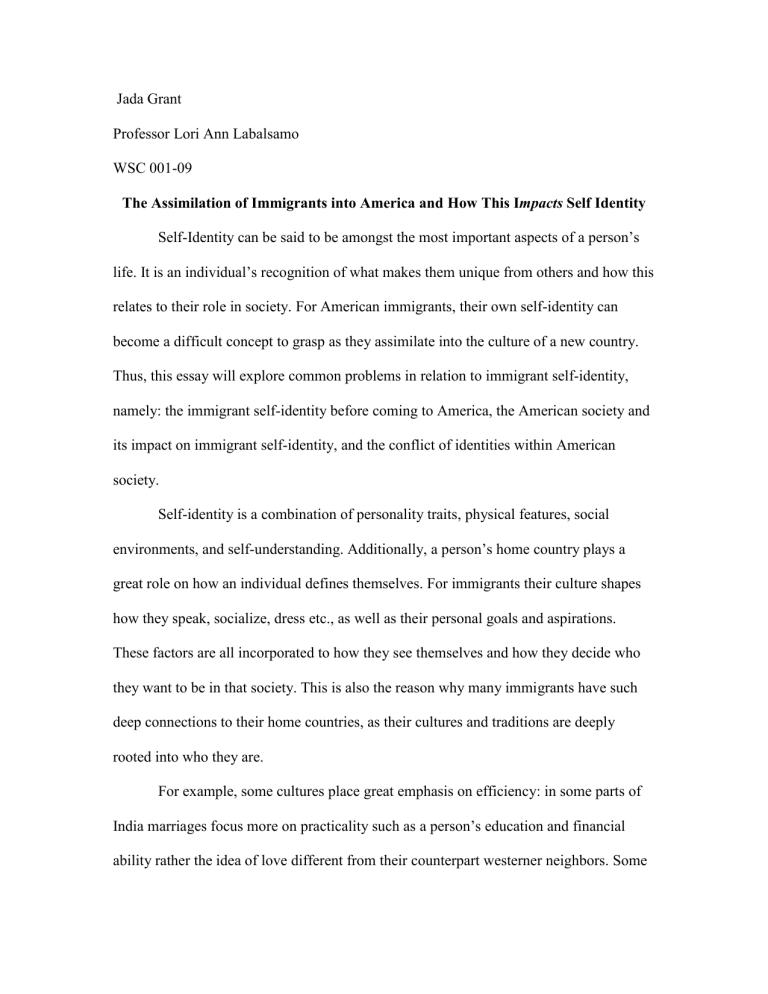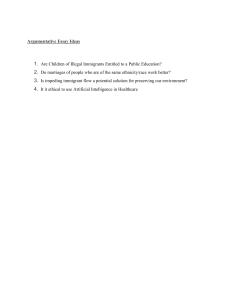
Jada Grant Professor Lori Ann Labalsamo WSC 001-09 The Assimilation of Immigrants into America and How This Impacts Self Identity Self-Identity can be said to be amongst the most important aspects of a person’s life. It is an individual’s recognition of what makes them unique from others and how this relates to their role in society. For American immigrants, their own self-identity can become a difficult concept to grasp as they assimilate into the culture of a new country. Thus, this essay will explore common problems in relation to immigrant self-identity, namely: the immigrant self-identity before coming to America, the American society and its impact on immigrant self-identity, and the conflict of identities within American society. Self-identity is a combination of personality traits, physical features, social environments, and self-understanding. Additionally, a person’s home country plays a great role on how an individual defines themselves. For immigrants their culture shapes how they speak, socialize, dress etc., as well as their personal goals and aspirations. These factors are all incorporated to how they see themselves and how they decide who they want to be in that society. This is also the reason why many immigrants have such deep connections to their home countries, as their cultures and traditions are deeply rooted into who they are. For example, some cultures place great emphasis on efficiency: in some parts of India marriages focus more on practicality such as a person’s education and financial ability rather the idea of love different from their counterpart westerner neighbors. Some eastern cultures place great importance in seniority while westerner’s focus more on individuality. Lastly, some cultures are more traditional and conservative while America emphasizes freedom of choice. These differences make the immigrant experience challenging as immigrants are faced with the battle of conforming to this difference which in some way alters their identity. Though America is usually seen as the land of opportunity, diversity and freedom, immigrants may realize that upon coming to the country their differences may not be as passionately embraced as they would have expected. Though American culture is in fact diverse and free, the country faces its own identity dilemma. This is because with such a diverse culture there can be difficulty tying its people together. Hence, Americans may prefer that the residents of its nation fully embrace the title of America and all that comes with it; especially when loyalty to one nation is needed. For immigrants this is a difficult idea to face. This is because to fully embrace a culture and to be defined as solely American means that they would have to, for the most part, rid themselves of their past. The problem with this is that as discussed earlier a person’s self-identity is deeply intertwined with their upbringing and culture. For one to rid themselves of their old culture they would have to lose a large part of who they are. For immigrants: the choice between the old identity and the new identity can cause significant internal and external conflict. Nevertheless, a choice still must be made. For many immigrants they have think deeply on the reasons why they came to America. For most, the pull factors of freedom, equality, ability to earn, access to education and equality of genders are what made the leave their countries. Though they may love their country and culture, there are factors, sometimes life threating, that may force them to leave it behind. Unless their past is something that they don’t want to remember, most immigrants find it difficult to accept the change in self that being American expects from them. For some immigrants, their self-identity is so deeply rooted in their countries culture that they may refuse to let it go. Their religious beliefs and upbringing define who they are. They find it difficult to adjust as see themselves as traditional, as conservative, as practical, and as respectful to elders. The sister in Mukherjee’s essay explains this concept by saying “I feel some kind of irrational attachment to India that I don’t to America.” For her and many others, the mere concept of seeking a better life is inferior and not enough to change them because for these immigrants, what they want from America is not superior to who they once were and still will be. Contrary, for many the cultural difference in America is what changes them. Whether it be the newfound freedom and self-expression or the newfound opportunities, these immigrants are given the opportunity to become someone new and to start over. This new self-identity provides them with something that could have otherwise been unattainable in their old countries. Though this self-identity dilemma does exist, it does not mean that an immigrant must choose one between their old identity and the one they have in America see themselves as both. This is even more true for the offspring of these immigrants. To many of those born to immigrant families, the past and the present are of equal importance to them and hence they choose to belong in the category of Americans that stem from the disparity of simultaneously being American and from another country. Hyphenated-American is the phrase given to citizens of America who choose to be recognized by a compound nationality. Immigrants who chose this title are the ones who hold on to their traditions and culture (who they are and how they are raised) while they adjust to accept American culture (societal impact) as a part of who they are. Louie describes this experience well by saying “I wholeheartedly disagree with that fear as my own identification as a Chinese-American in no way lessens my patriotism or allegiance to the United States…it magnifies my loyalty since the description of myself as ChineseAmerican or Asian-American is to inform others of my Americanism while also paying tribute and acknowledging the part of me that is different from that of an ItalianAmerican or Jewish-American.” Though I may not be an immigrant in America, I can relate to the experiences and concerns that come living in a country that isn’t your birthplace. I have discovered that though my own cultural traditions are deeply intertwined into who I am, I have still had to change and adapt to American culture. I discovered a new version of myself in America; I have had to adapt to how locals speak, interact, think, etc. Like many immigrants I came here for the opportunity to further my education, hence, like them, I need to assimilate into American culture. Nevertheless, I chose to hold onto my Identity as a Jamaican because my own cultural experiences are a large part of my self-identity. The self-identity problem that every immigrant faces at some point in their assimilation into American culture is a direct result of the differences between cultures and traditions. This choice between one’s old self and one’s new self is a difficult task as there are various changes to oneself that happens in the process. Mukherjee describes as “The price that the immigrant willingly pays, and that the exile avoids, is the trauma of self-transformation.” To fit into the culture of a country that is inherently different from your own one has to sacrifice a lot of themselves.


